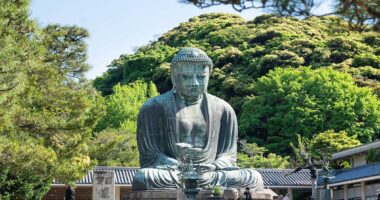Hase Temple (“Hasedera” in Japanese) is a beloved tourist destination in Japan, known year-round as the “Temple of Flowers.” Located in Kamakura City, Kanagawa Prefecture, the area is surrounded by historic temples, serene shrines, and charming eateries. This makes it an ideal spot for combining sightseeing with relaxation.
Refresh your mind and body at the nature-filled Hase Temple
Upon arrival at Hase Temple, the iconic sanmon entrance gate, adorned with a red lantern inscribed “Hase Temple,” warmly welcomes visitors. Start your journey by purchasing an admission ticket at the reception next to the gate.

sanmon
As you pass through the gate, you’ll enter the lower grounds, featuring a koi pond and a meticulously maintained Japanese garden. This serene area changes with the seasons, showcasing vibrant flowers and foliage throughout the year.

Ascending the stone steps leading to the main worship hall known as Kannon-dō, you’ll enjoy the tranquil sights of moss-covered walls and lush green slopes.
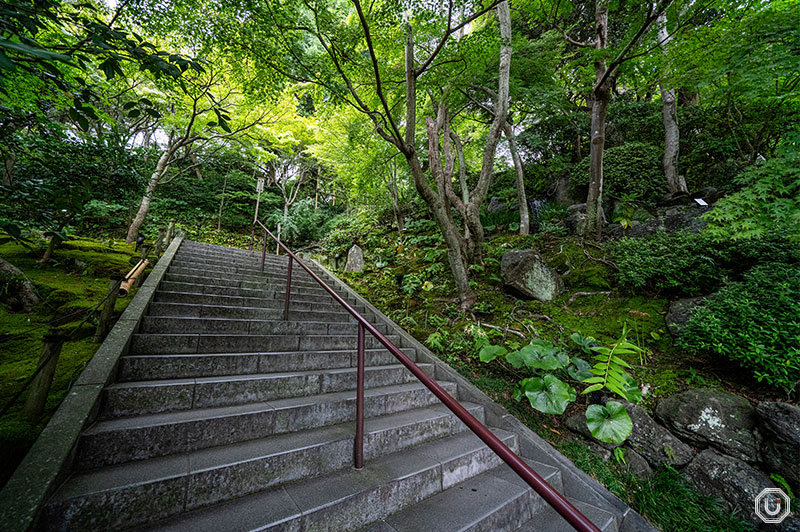
Along the way, there’s a photo spot you won’t want to miss: Ryo-en Jizō statues, adorable depictions of Jizo, a Buddhist deity believed to protect children and give prosperity to one’s descendants.
These statues have been getting more popular in recent years. They are located in three places within the temple grounds, and it’s said that finding and praying at all three brings blessings for ryo-en, meaning “good relations.”

“良縁地蔵,” Ryo-en Jizo
Halfway up the stairs is Jizō-dō Hall, dedicated to prayers for the prosperity of descendants. The area around the hall is adorned with numerous Jizo statues offered by worshippers. Both this area and the hall are popular as photo spots.
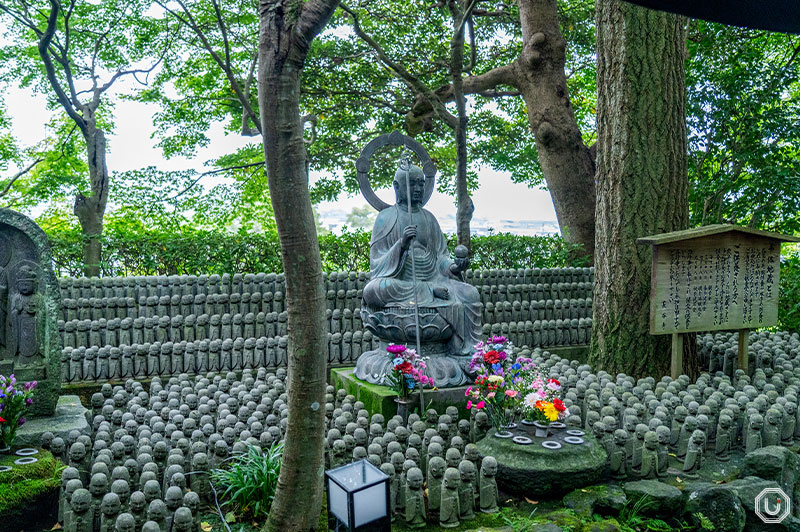
At the top of the hill, you’ll reach Kannon-do. Hase Temple was established in the 8th century and boasts a rich history, though the main hall has been reconstructed several times, with the current structure completed in 1986.

Main worship hall
Inside, the highlight is the stunning Jūichimen Kannon Bosatsu-zō (statue of Kannon Bodhisattva with Eleven Heads). Standing an impressive nine meters (nearly 30 feet) tall, it’s one of the largest wooden Buddhist statues in Japan. After offering a small donation, take a moment to quietly pray before this magnificent figure.
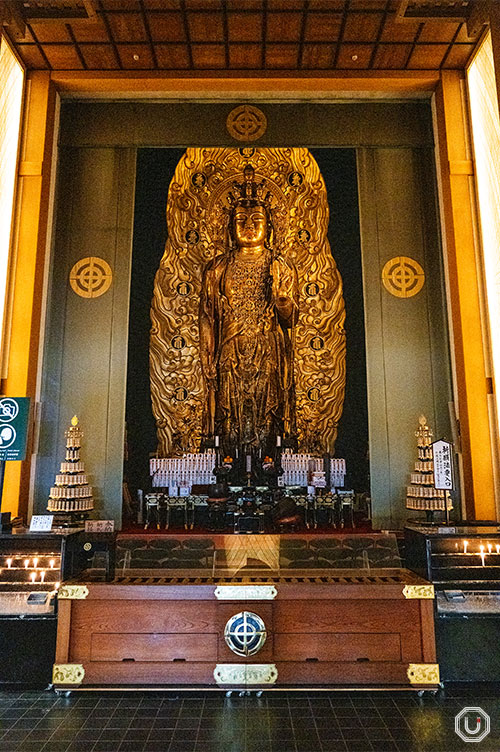
“十一面観音菩薩像,” Jūichimen Kannon Bosatsu-zō (photography normally prohibited)
Next to Kannon-do is Amida-dō Hall, home to a statue of the Amida Buddha. This hall was built at the request of Minamoto no Yoritomo, the first shogun of the Kamakura period (1185–1333), to ward off misfortune.

“阿弥陀堂,” Amida-do Hall
Inside Amida-do Hall, seating is available for visitors to quietly reflect and appreciate the Buddha statue. Interestingly, this statue originally wasn’t within Hase Temple but belonged to a nearby temple that no longer exists.

The lower grounds also feature the cool Benten-kutsu Cave, the walls of which are chiseled out to form statues of Benzaiten, the goddess of fortune, and her 16 disciples.
As you head towards the exit, your heart may beat just a bit faster from the excitement of navigating the narrowing cave, requiring you to stoop down as you go. It’s a popular spot enjoyed by both Japanese and international visitors.

“弁天窟,” Benten-kutsu Cave
Outside the cave, a nearby pond offers a place to offer wooden kigan fuda (wish plaques) which have been purified in water.

The kigan fuda are separated into specific wishes such as business prosperity, family safety, the blessing of children, and recovery from illness. After offering the indicated fee, write your name and age on the back of your chosen plaque.

“祈願札,” kigan fuda 300 JPY
Place the plaque in the small bamboo basket provided for that purpose, purify it with water, then offer it to the temple.

At Hase Temple, you can try your hand at shakyō (sutra copying) or shabutsu (tracing a Buddha image). Available from 9:00 AM to 1:00 PM, the activity takes place in a wooden hall in the lower grounds. Simply purchase a sheet for 1,200 JPY, and you’re ready to begin.
A variety of tools are provided, including traditional inkstones and brushes as well as modern brush pens and ballpoint pens, making it easy and accessible for everyone. The process of carefully copying each character or image is deeply meditative and is certain to leave you feeling at peace.

The hall’s surrounding garden features a beautiful karesansui (rock garden). Since there are only a limited number of rock gardens in Kamakura, it’s a popular spot. Quietly contemplating its beauty is sure to soothe your heart.

Behind the main hall is a scenic walking path with slopes and steps. On clear days, it offers stunning views of Yuigahama Beach and the surrounding townscape. Lined with approximately 2,500 hydrangea plants in over 40 varieties, the path bursts into a spectacular display of blooms around June each year—a truly unforgettable sight!
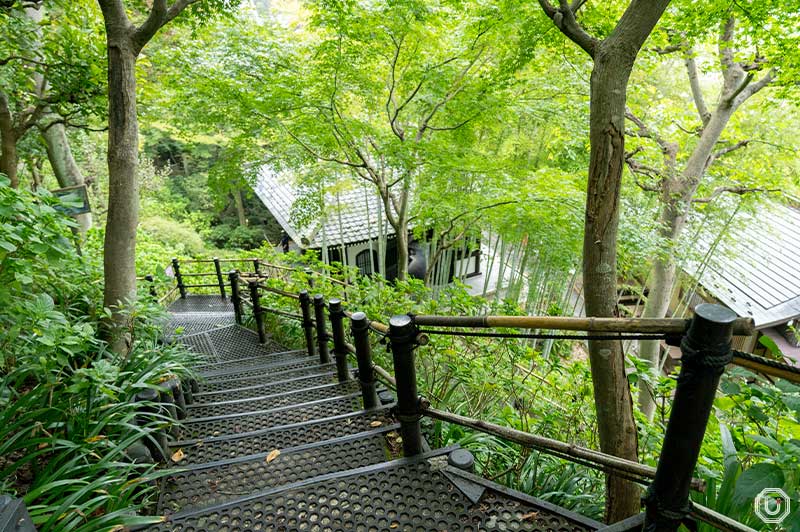
Scenic walking path
Hase Temple also offers a variety of omamori (amulets available at Japanese shrines and temples and granting good luck or protection), including the cute strawberry-shaped “Kanau Mamori” for fulfilling your wishes.

“願叶守,” Kanau Mamori 700 JPY
The Migawari Suzu (literally “stand-in bell”) is one of the most popular amulets at Hase Temple. This clay bell is said to take on misfortunes in your place, protecting you from harm. They come in a variety of colors, so be sure to find one that suits your preference!

“みがわり鈴,” Migawari Suzu 1,000 JPY
Moreover, you can obtain goshuin (special seals obtained from Japanese temples and shrines as proof of pilgrimage) to commemorate your visit to the Kannon statue in the main hall. Several types are available, including embroidered and kirie (Japanese paper-cutting art) designs.
Please note that in January, April, May, and June, goshuin cannot be written directly in your goshuinchō (seal book); only pre-prepared paper goshuin will be available.

Goshuin 500 JPY
If you’re looking for souvenirs beyond kigan fuda or omamori, head to the Nagomi Shop—nagomi meaning “comforting” in Japanese—located next to the reception. The shop features a variety of lovely Hase Temple souvenirs, with a focus on items inspired by the smiling Nagomi Jizo.
Next door, you’ll find Teraya Café, where you can enjoy coffee or soft-serve ice cream—perfect for a quick break.

“なごみショップ,” Nagomi Shop
For a full meal with scenic views, visit the Kaikōan restaurant in the upper grounds, where you can enjoy delicious food alongside breathtaking views of Kamakura.

“海光庵,” Kaikōan restaurant
Hase Temple may be small in size, but it offers countless ways to enjoy your visit—whether it’s strolling through the grounds, savoring a meal, or trying your hand at shakyo.
One visit simply isn’t enough! It’s a place you’ll want to return to again and again, with each season bringing something new to discover.
Temple Information
| Name | 長谷寺 Hase Temple |
|---|---|
| Address | 3-11-2 Hase, Kamakura-shi, Kanagawa Prefecture
|
| Access |
Hase Station 5-minute walk from exit
|
| Phone number | 0467-22-6300 |
| Visiting hours | Jan-Mar. 8:00-16:30 (closes at 17:00) Apr-Jun. 8:00-17:00 (closes at 17:30) Jul-Dec. 8:00-16:30 (closes at 17:00) |
| Sacred items | 8:00-16:30 |
| Goshuin | 8:00-16:00 |
| Omikuji | 8:00-16:30 |
| Admission fee | Adults 400 JPY Elementary school students 200 JPY With Kamakura City Fukuju Handbook 200 JPY |
| Official website | https://www.hasedera.jp/en |
| Other information |
|
※The information in this article is current as of November 2024.



